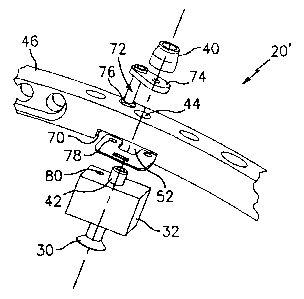Some of the information on this Web page has been provided by external sources. The Government of Canada is not responsible for the accuracy, reliability or currency of the information supplied by external sources. Users wishing to rely upon this information should consult directly with the source of the information. Content provided by external sources is not subject to official languages, privacy and accessibility requirements.
Any discrepancies in the text and image of the Claims and Abstract are due to differing posting times. Text of the Claims and Abstract are posted:
| (12) Patent Application: | (11) CA 2442358 |
|---|---|
| (54) English Title: | SHIM LOCK/PIN ANTI-ROTATION BUMPER DESIGN |
| (54) French Title: | CONCEPTION DE SYSTEME DE BUTOIR A CALE D'ARRET/TIGE |
| Status: | Deemed Abandoned and Beyond the Period of Reinstatement - Pending Response to Notice of Disregarded Communication |
| (51) International Patent Classification (IPC): |
|
|---|---|
| (72) Inventors : |
|
| (73) Owners : |
|
| (71) Applicants : |
|
| (74) Agent: | NORTON ROSE FULBRIGHT CANADA LLP/S.E.N.C.R.L., S.R.L. |
| (74) Associate agent: | |
| (45) Issued: | |
| (22) Filed Date: | 2003-09-24 |
| (41) Open to Public Inspection: | 2004-03-30 |
| Examination requested: | 2003-09-24 |
| Availability of licence: | N/A |
| Dedicated to the Public: | N/A |
| (25) Language of filing: | English |
| Patent Cooperation Treaty (PCT): | No |
|---|
| (30) Application Priority Data: | ||||||
|---|---|---|---|---|---|---|
|
The present invention relates to a bumper system for use with a compressor
variable vane
system. The bumper system broadly comprises a synchronizing ring, a bumper, a
shim for
defining a gap between a bumper pad and the bumper, a pin for preventing
rotation of the
bumper relative to the synchronizing ring, and a device for fully trapping the
shim. In a first
embodiment, the device for fully trapping the shim comprises a sleeve passing
through the
synchronizing ring. In a second embodiment, the device for fully trapping the
shim comprises a
pin which passes through the synchronizing body. In a third embodiment, the
device for fully
trapping the shim comprises a fastener with a shoulder.
Note: Claims are shown in the official language in which they were submitted.
Note: Descriptions are shown in the official language in which they were submitted.

2024-08-01:As part of the Next Generation Patents (NGP) transition, the Canadian Patents Database (CPD) now contains a more detailed Event History, which replicates the Event Log of our new back-office solution.
Please note that "Inactive:" events refers to events no longer in use in our new back-office solution.
For a clearer understanding of the status of the application/patent presented on this page, the site Disclaimer , as well as the definitions for Patent , Event History , Maintenance Fee and Payment History should be consulted.
| Description | Date |
|---|---|
| Time Limit for Reversal Expired | 2008-09-24 |
| Application Not Reinstated by Deadline | 2008-09-24 |
| Inactive: Abandoned - No reply to s.30(2) Rules requisition | 2007-11-14 |
| Deemed Abandoned - Failure to Respond to Maintenance Fee Notice | 2007-09-24 |
| Inactive: S.30(2) Rules - Examiner requisition | 2007-05-14 |
| Amendment Received - Voluntary Amendment | 2006-09-20 |
| Inactive: S.30(2) Rules - Examiner requisition | 2006-03-21 |
| Inactive: IPC from MCD | 2006-03-12 |
| Application Published (Open to Public Inspection) | 2004-03-30 |
| Inactive: Cover page published | 2004-03-29 |
| Letter Sent | 2004-03-11 |
| Letter Sent | 2004-03-11 |
| Letter Sent | 2004-03-11 |
| Inactive: Single transfer | 2004-02-23 |
| Inactive: First IPC assigned | 2003-11-28 |
| Inactive: Courtesy letter - Evidence | 2003-10-28 |
| Filing Requirements Determined Compliant | 2003-10-22 |
| Inactive: Filing certificate - RFE (English) | 2003-10-22 |
| Application Received - Regular National | 2003-10-21 |
| Letter Sent | 2003-10-21 |
| Request for Examination Requirements Determined Compliant | 2003-09-24 |
| All Requirements for Examination Determined Compliant | 2003-09-24 |
| Abandonment Date | Reason | Reinstatement Date |
|---|---|---|
| 2007-09-24 |
The last payment was received on 2006-09-06
Note : If the full payment has not been received on or before the date indicated, a further fee may be required which may be one of the following
Please refer to the CIPO Patent Fees web page to see all current fee amounts.
| Fee Type | Anniversary Year | Due Date | Paid Date |
|---|---|---|---|
| Application fee - standard | 2003-09-24 | ||
| Request for examination - standard | 2003-09-24 | ||
| Registration of a document | 2004-02-23 | ||
| MF (application, 2nd anniv.) - standard | 02 | 2005-09-26 | 2005-08-31 |
| MF (application, 3rd anniv.) - standard | 03 | 2006-09-25 | 2006-09-06 |
Note: Records showing the ownership history in alphabetical order.
| Current Owners on Record |
|---|
| UNITED TECHNOLOGIES CORPORATION |
| Past Owners on Record |
|---|
| ANTHONY R. BIFULCO |
| JOHN T. PICKENS |
| KEVIN J. CUMMINGS |
| PHILLIP ALEXANDER |